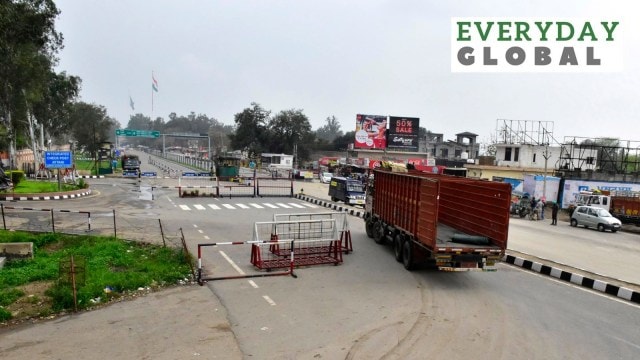Pakistan may ‘seriously examine’ resuming trade with India: Why it paused, what it constituted
Pakistan suspended bilateral trade with India in August 2019, following the Indian government’s abrogation of Article 370 of the Indian Constitution. What happened at the time, and why has the possibility of resumption been raised now? We explain.
 A view of closed gate of the Attari Wagah Joint Check Post in 2020. (Express photo by Rana Simranjit Singh)
A view of closed gate of the Attari Wagah Joint Check Post in 2020. (Express photo by Rana Simranjit Singh)Pakistan’s Foreign Affairs Minister Ishaq Dar said on Saturday (March 23) that the country will “seriously examine” the question of resuming trade with India. Bilateral trade between India and Pakistan has been halted since 2019.
Pakistani newspaper Dawn reported on Dar’s press conference in London, where he said all stakeholders would sit together, citing his recent discussions with Pakistani traders. He said, “Everyone’s appeal was the same — that our imports, which are still ongoing, arrive via Dubai or Singapore, [resulting in] extra freight, extra transhipment, transportation costs, etc.”
Why has trade with Pakistan been largely stopped for nearly five years? What goods did India export to Pakistan, and what might explain the possibility of a change? We explain.
Why was India-Pakistan trade paused?
Pakistan suspended bilateral trade with India in August 2019, after the Indian government abrogated Article 370 of the Indian Constitution. The now-scrapped article gave a special status to the erstwhile state of Jammu and Kashmir, following its accession with India in 1947.
“As a party to this international dispute, Pakistan will exercise all possible options to counter the illegal steps,” said Pakistan’s Foreign Office at the time, referring to its claims on the region.
However, as The Indian Express reported previously, “an underlying reason for suspending trade was the 200 per cent tariff imposed by New Delhi on Pakistani imports earlier that year after India revoked Pakistan’s Most Favoured Nation (MFN) status”.
India took this step in the aftermath of the Pulwama terrorist attack the same year. On February 14, 2019, a terrorist from the Pakistani group Jaish-e-Muhammad rammed an explosives-laden car into a convoy of the Central Reserve Police Force (CRPF) at Lethpora, a village in Pulwama, on the Srinagar-Jammu National Highway. It led to the deaths of 40 personnel.
India withdrew Pakistan’s MFN status within 24 hours of the attack. Part of the World Trade Organisation’s General Agreement on Tariffs and Trade (GATT), 1994, the idea here is that all member countries of the WTO should accord MFN status to all other member countries. This would ensure free and open trade and that all members treat each other equally as trade partners.
What was the composition of India-Pakistan trade?
Despite having MFN status since 1996, Pakistan maintained a Negative List of 1,209 products that were not allowed to be imported from India. Only 138 products were allowed to be imported from India through the Wagah-Attari border land route.
Still, India maintained a significant trade surplus over Pakistan, meaning the total value of goods and services it exported to Pakistan was much larger than the value of goods and services it imported from Pakistan.
Even this number was not very significant compared to the status of trade with other countries. In FY17, India-Pakistan trade was a mere $2.29 billion, or about 0.35% of India’s overall trade.
In 2018-19, cotton ($550.33 million) and organic chemicals ($457.75 million) accounted for around half of Pakistan’s imports from India. Other major Pakistani imports from India that year included plastic ($131.19 million), tanning/dyeing extracts ($114.48 million), and nuclear reactors, boilers, machinery, and mechanical appliances ($94.88 million).
Meanwhile, India’s imports from Pakistan in 2018-9 included mineral fuels and oils ($131.29 million), edible fruits and nuts ($103.27 million), salt, sulphur, stone and plastering materials ($92.84 million), ores, slag and ash ($17.18 million) and raw hides and leather ($16.27 million).
What was the fallout?
After the ban, Pakistan’s imports of these five products fell drastically between April 2020 and January 2021, while cotton imports stopped altogether. The only increase was in pharmaceutical products, as Pakistan looked to ensure sufficient supplies of medicines during the Covid-19 pandemic.
Earlier this year, the government said some amount of trade with Pakistan is being conducted through land and sea routes but all business through the land border has been stopped by the neighbouring country “unilaterally”.
Previously, whatever trade had happened, everything was done through the Wagah-Attari border and Karachi port, according to Union Minister of State for Commerce and Industry Anupriya Patel.
Has anything changed since then?
This is not the first time that Pakistan has spoken of resuming trade. In 2021, Pakistan’s Economic Coordination Council, a top decision-making body, allowed the import of cotton and yarn from India. A low domestic yield and the high cost of imports from the likes of Brazil and the United States were believed to be the reasons behind the change of stance.
However, it again took a U-turn, with then Prime Minister Imran Khan saying trade could not continue given the circumstances of that time.
Why might Pakistan be reconsidering trade with India?
Although Dar did not equivocally speak about the resumption of trade, several factors may be behind a softening in Pakistan’s stand. For one, there has been a change of face, if not regime, since Imran Khan following elections held earlier this year. While the Pakistani military remains firmly in control, a new government indicates the possibility of a new policy.
It could also be done given the context of Pakistan’s economy, which has been in dire condition. Devastating floods in 2022, high inflation, and political instability alongside structural issues, have led to multiple crises related to meeting the food and energy needs of the population.
The country has had to frequently approach the International Monetary Fund (IMF) or friendly countries like Saudi Arabia and China for billions of dollars in loans. With the pause in trade with India, Importing goods from faraway countries further depletes its low foreign exchange reserves.
Some Indian traders, particularly in Punjab, have also expressed the hope for trade to continue. Rajinder Singh Marwaha, Chairman World Sikh Chamber of Commerce told The Indian Express that trade through the Integrated Check Post (ICP) at Attari would also help reach Central Asian markets. He added that trading with Pakistan currently involves going through Iran or Dubai, adding to costs.



- 01
- 02
- 03
- 04
- 05


































